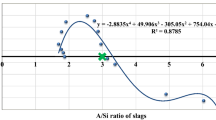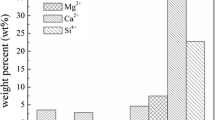Abstract
Slag-type silicate fertilizer, which contains high amount of active iron oxide, a potential source of electron acceptor, was applied at the rate of 0, 2, 6, 10, and 20 Mg ha−1 to reduce methane (CH4) emission from rice planted in potted soils. Methane emission rates measured by closed chamber method decreased significantly with increasing levels of silicate fertilizer application during rice cultivation. Soil redox potential (Eh) decreased rapidly after flooding, but floodwater pH and soil pH increased significantly with increasing levels of silicate fertilizer application. Iron concentrations in potted soils and in percolated water significantly increased with the increasing levels of silicate fertilizer application, which acted as oxidizing agents and electron acceptors, and thereby suppressed CH4 emissions. Silicate fertilization significantly decreased CH4 production activity, while it increased carbon dioxide (CO2) production activity. Rice plant growth, yield parameters, and grain yield were positively influenced by silicate application levels. The maximum increase in grain yield (17% yield increase over the control) was found with 10 Mg ha−1 silicate application along with 28% reduction in total CH4 flux during rice cultivation. It is, therefore, concluded that slag-type silicate fertilizer could be a suitable soil amendment for reducing CH4 emissions as well as sustaining rice productivity and restoring the soil nutrient balance in rice paddy soil.



Similar content being viewed by others
References
Adhya TK, Rath AK, Gupta PK, Rao VR, Das SN, Parida KM, Parashar DC, Sethunathan S (1994) Methane emission from flooded rice fields under irrigated conditions. Biol Fertil Soils 18:245–248
Allison LE (1965) Organic carbon, In: Black CA, Evans DD, White JL, Ensminger LE, Clark FE (eds) Methods of soil analysis, part 2. American Society of Agronomy, Madison, WI, USA, pp 1367–1376
Anonymous (1990) SAS/STAT User’s guide, vol.1, ACECLUS-FREQ, version 6, 4th edition. SAS Institute, Inc., Cary, NC
Asami T, Takai Y (1970) Behaviour of free iron oxide in paddy soil (part 4), Reduction of free iron oxide and metabolisms of various gases in paddy soil. Jpn J Soil Sci Plant Nutr 41:48–55
Aulakh MS, Bodenbender J, Wassmann R, Rennenberg H (2000) Methane transport capacity of rice plants: influence of methane concentration and growth stage analyzed with an automated measuring system. Nutr Cycl Agroecosyst 58:357–366
Bohn M, McNeal G, Connor GO (1979) Soil chemistry. New York, Chichester Brisane Toronto: A Wiley-Interscience Publication
Bouwman AF (1991) Agronomic aspects of wetland rice cultivation and associated methane emissions. Biogeochemistry 15:65–88
Denier van Der Gon HAC, Neue HU (1995) Influence of organic matter incorporation on methane emission from a wetland rice field. Glob Biogeochem Cycles 9:11–22
Denier van Der Gon HAC, Kropff MJ, van Breemen N, Wassmann R, Lantin RS, Aduna E, Corton TM (2002) Optimizing grain yields reduces CH4 emissions from rice paddy fields. Proc Natl Acad Sci USA 99:12021–12024
Deren CW, Datnoff LE, Snyder GH, Martin FG (1994) Silicon concentration, disease response and yield components of rice genotypes grown on flooded organic histosols. Crop Sci 34:733–737
Furukawa Y, Inubushi K (2002) Feasible suppression technique of methane emission from paddy soil by iron amendment. Nutr Cycl Agroecosyst 64:193–201
Furukawa Y, Inubushi K (2004) Evaluation of slag application to decrease methane emission from paddy soil and fate of iron. Soil Sci Plant Nutr 50:1029–1036
Garica JL, Patel BKC, Ollivier O (2000) Taxonomic, phylogenetic and ecological diversity of methanogenic archaea. Anaerobe 6:205–226
Gerard G, Chanton J (1993) Quantification of methane oxidation in the rhizosphere of emergent aquatic macrophytes: defining upper limits. Biogeochemistry 23:79–97
Gogoi N, Barua KK, Gogoi B, Gupta PK (2005) Methane emission characteristics and its relations with plant and soil parameters under irrigated rice ecosystem of northeast India. Chemosphere 59:1677–1684
Hanson RS (1980) Ecology and diversity of methylotrophic organisms. Adv Appl Microbiol 26:13–40
Hu DJ, Wang FH (1995) Silica nutrition of rice. Agric Sci Hubei 5:33–36
Husin YA, Khalil MAK, Shearer MJ (1995) Methane flux from Indonesian wetland rice: the effects of water management and rice variety. Chemosphere 31:3153–3180
Inubushi K, Hori K, Matsumoto S, Wada H (1997) Anaerobic decomposition of organic carbon in paddy soil in relation to methane emission to the atmosphere. Water Sci Technol 36:523–530
IPCC (1996) XII Summary for policy makers, In: Houghton IT, Meira F, Callander LG, Harris BA, Kattenberg A, Maskell K (eds) Climate change 1995: the scientific basis of climate. Cambridge University Press, Cambridge, UK, p. 572
Jensen CR, Luxmoore RJ, Van Gundy SD, Stolzy LH (1969) Root air-space measurements by a pycnometer method. Agron J 61:474–475
Khalil MAK, Rasmussen RA (1990) Emissions of trace gases from Chinese rice fields and biogas generators: CH4, N2O, CO, CO2, chlorocarbons and hydrocarbons: chemosphere 20:207–226
Lee YB, Lee CH, Hawng JY, Lee IB, Kim PJ (2004) Enhancement of phosphate desorption by silicate in soils with salt accumulation. Soil Sci Plant Nutri 50:493–499
Loeppert RH, Inskeep WP (1996) Iron. In: Sparks DL, Page AL, Loeppert RH, Johnston CT, Sumner ME, Bigham JM (eds) Methods of soil analysis. Part 3, Chemical methods. Soil Science Society of America and American Society of Agronomy, Madison,W1, pp 639–664
Ma JF, Nishimura K, Takahashi E (1989) Effect of silicon on the growth of rice plant at different growth stages. Soil Sci Plant Nutr 35:347–356
Mariko S, Harazano Y, Owa N, Nouchi I (1991) Methane in flooded soil water and the emission through rice plants to atmosphere. Environ Exp Bot 31:343–350
Neue HU, Roger PA (1993) Rice agriculture: factors affecting methane emissions, In: Khalil MAK (ed) Atmospheric methane: sources, sinks and role in global change. Springer, Berlin, pp 254–298
Nouchi I, Hosono T, Aoko K, Minami K (1994) Seasonal variation in methane flux from rice paddies associated with methane concentration in soil water, rice biomass and temperature, and its modeling. Plant Soil 161:195–208
Olson RV, Ellis R (1982) Iron. In: Page AL (ed) Methods of soil analysis, part 2. Agron. Monogr. 9. Soil Science Society of America and American Society of Agronomy, Madison,W1, pp 301–312
Ponnamperuma FN (1965b) Review of the symposium on the mineral nutrition of the rice plant, In: The mineral nutrition of rice plant. Johns Hopkins University Press, Baltimore MD, pp 461–482
Prinn RG (1994) Global atmospheric-biospheric chemistry. In: Prinn RG (ed) Global Atmospheric-Biospheric Chemistry. Plenum, New York, pp 1–18
RDA, Rural Development Administration, (1988) Method of soil chemical analysis. National Institute of Agricultural Science and Technology, Suwon, Korea
RDA, Rural Development Administration, (1999) Fertilization standard of crop plants, National Institute of Agricultural Science and Technology, Suwon, p 148
Rolston DE (1986) Gas flux, In: Klute A (ed) Methods of soil analysis, part 1, 2nd ed., Agron. Monogr. 9. Soil Science Society of America and American Society of Agronomy, Madison,W1, pp 1103–1119
Roy AC, Ali MY, Fox RL, Silva JA (1971) Influence of calcium silicate on phosphate solubility and availability in Hawaiian latosols. In: Proceedings of international symposium on soil fertility evaluation, Vol. 1. New Delhi, pp 757–765
Schimel J (2000) Rice, microbes and methane. Nature 403:375–377
Shariatmadari H, Mermut AR (1999) Magnesium and silicon induced phosphate in smectite, palygorskite, and sepiolite-calcite systems. Soil Sci Soc Am J 63:1167–1173
Shin YK, Yun SH, Park ME (1995) Estimation of methane emission by water management and rice straw application in paddy soil in Korea. Journal of Korean Society of Soil Science and Fertilizer 28:261–265
Singh JS, Singh S (1995) Methanogenic bacteria, methanogenesis and methane emission from rice paddies. Trop Ecol 36:145–165
Singh S, Singh JS, Kashyap AK (1999) Methane flux from irrigated rice fields in relation to crop growth and N-fertilization. Soil Biol Biochem 31:1219–1228
Steele LP, Fraser PJ, Rasmussen RA, Khalil MAK, Conway TJ, Crawford AJ, Gammon RH, Masarie KA, Thoning KW (1987) The global distribution of methane in the troposphere. J Atmos Chem 5:127–171
Takai Y (1961) Reduction and microbial metabolism in paddy soil. Nogyo Gijutsu (Agricultural Technology) 16:122–126
Wassmann R, Papen H, Rennenberg H (1993) Methane emission from rice paddies and possible mitigation strategies. Chemosphere 26:201–217
Watanabe A, Kimura M (1999) Influence of chemical properties of soils on methane emissions from rice paddies. Commun Soil Sci Plant Anal 30:2449–2463
Yagi K, Minami K (1990) Effect of organic matter application on methane emission from some Japanese paddy fields. Soil Sci Plant Nutr 36:599–610
Yoshiba M, Morimura T, Aso S, Takenaga H (1996) Methane production and control in submerged soil applied with Mn4+, Fe2+ and \({\text{SO}}^{{{\text{2 - }}}}_{{\text{4}}} \) rich materials. Jpn J Soil Sci Plant Nutr 67:362–370
Yoshida S (1981) Fundamental of rice crop science. International Rice Research Institute, Los Banos, Laguna, Philippines
Acknowledgements
This research work was supported by the Korean Research Foundation Grant funded by the Korean Government (MOEHRD) (KRF-2006-F00010) and Dr. Chang Hoon Lee is supported by the Scholarship form the BK21 program, Ministry of Education and Human resource Development, Korea.
Author information
Authors and Affiliations
Corresponding author
Rights and permissions
About this article
Cite this article
Ali, M.A., Lee, C.H. & Kim, P.J. Effect of silicate fertilizer on reducing methane emission during rice cultivation. Biol Fertil Soils 44, 597–604 (2008). https://doi.org/10.1007/s00374-007-0243-5
Received:
Revised:
Accepted:
Published:
Issue Date:
DOI: https://doi.org/10.1007/s00374-007-0243-5




